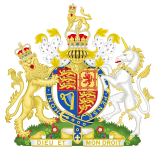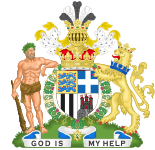On this day in 2002, the Queen Mother died. She was 101. (I wonder what message the obligatory birthday card the Queen sends all of her subjects on reaching 100 will have conveyed to her mother.)
I aim to follow suit. (This information may cause dismay among my small circle.) Perhaps you would like to as well. So, with the goal of securing our longevity, it occurred to me that emulating the Queen Mum’s diet might be the secret to follow.
There was no need to invoke a Freedom of Information request to unearth it. It isn’t hard to discover the restorative foods and liquids the Queen Mother was fond enough of that she conferred a Royal Warrant upon the companies producing them.
An imprimatur of their approval, Royal Warrants have been issued by senior royals since the 15th century to carefully selected purveyors of goods and services to the Court - a kind of ‘Like’ emoji but of superior design. This is the Queen's Royal Warrant.
This was Prince Philip’s. If you can’t distinguish it, I can tell you the expression on the face of the Tarzan figure is very angry indeed. Hangry, perhaps, as the popular conflation of angry and hungry goes. But it may be rather the puzzlement a man in an animal skin might feel on finding himself leaning at one end of a convoluted mantelpiece-like structure with a salivating lion in designer neckwear at the other.
The Queen Mum is unlikely to have been hangry. Among the brands she selected for honouring with her imprimatur were:
Gordons Gin and Gordons Vodka, Tanqueray Gin, Bacardi-Martini, Bollinger, Veuve Cliquot, Chivas Regal, Sandeman Sherry, Johnnie Walker whisky, Charbonnel et Walker chocolates, Bendicks Mints, Pinney's Smoked Salmon, Twinings Tea and Coffee, Kelloggs and Weetabix breakfast cereals, bacon and sausages from the Scottish butcher local to the Castle of Mey where she lived when north of the border, Colman’s Mustard and HP Sauce which went with them very nicely, and Worcestershire Sauce for a lovely Bloody Mary with that Gordon’s Vodka to accompany a warrant-approved Full English breakfast.
There are other food treats of a similar nature too numerous to include. Just this limited inventory might be considered an exhilarating shopping spree for anyone aspiring to be sent that congratulatory 100th birthday card by the Queen. (Who, I wonder, will be responsible for signing hers?)
Alas, we are expected to reach our four-score-years-and-ten or more on a much healthier range of ingredients. By the middle of this century, there will be twice as many people over 65 than children under 5 and Big Food Biz has them in its sights. “The narrative on ageing needs to evolve,” says the Head of Sustainable and Thematic Investing of Barclays Bank, “…there are many opportunities for the nutrition industry [to adapt new products directed at the elderly]”. Just that ‘thematic’ in his job title should send a shiver up any Silver Surfer.
The nutrition industry already has cows wearing fitbits. A German company has developed chicken-free eggs. Cry-free onions have just landed in the high-end UK supermarket chain known not always fondly as Waitress. There’s already speculation that the traditional turkey for the Christmas table of 2050 might be replaced by turkey-style clam meat. I’m not persuaded, as the bivalve marketing press release was also excited by the proposal that muscle cakes would stand in for beef burgers. I hope not. Surely they meant ‘mussel’? Silver Surfers, you have been warned. The Queen Mother would not have stood for it.
What she was most fond of was chocolate, which may account for her longevity. A level of 50%-70% cacao and more in dark chocolate is full of antioxidants that attack damaging free radicals. Antioxidants have been shown to lower blood pressure, reduce the risk of clotting and increase blood circulation to the heart, lowering risks of stroke, coronary heart disease and death from heart disease.
The Olmec, one of the earliest civilizations in ancient Mesoamerica (the Mexico of today), knew all this 4000 years ago. They turned the seeds of the chocolate nibs (pods) from the plants they grew, and which were so valuable they functioned as currency, into a bitter drink they drank during the rituals that would take place before planting, to ensure the future health of the bush.
For four days and nights the seeds were exposed to moonlight and, according to 19th century historian, H.H. Bancroft, the tillers of the soil had to 'sleep apart from their wives and concubines for several days, in order that on the night before planting they might indulge their passions to the fullest extent.'
When Columbus presented cacao to the court of King Ferdinand on his return from his travels, it wasn't a success, probably because it was drunk highly spiced and sugarless, the Aztec and Mayan way. But 17 years later, in 1519, Cortes tried again, having slaughtered his host, Montezuma, who had thoightfully introduced him to the drink. This time, the Spaniards added two other New World discoveries - sugar and vanilla, making 'xocoatl' so much more palatable it quickly became the rage in fashionable society.
The Olmecs, Aztecs and Mayans also used the plant as medicine. In 18th century England, Sir Hans Sloane, personal physician to Queen Anne, along with diaryist Samuel Pepys, promoted its medicinal properties, encouraging the making of it with milk instead of water. But only in 1828 did Dutchman Coenraad J. Van Houten invent a press that could extract two thirds of the bean's 53% fat content, leaving a cake of powdered cocoa. Two decades on, the English confectionery firm of Joseph Fry added sugar and chocolate liquor from the roasted bean of the cocoa (the word the English found easier to pronounce than 'cacao') to the extracted cocoa butter, making the first edible chocolate.
When cooking with chocolate, always try to use chocolate with no less than 70% cocoa butter or cocoa solids. Chocolate below that percentage produces a far less intense flavour and an exaggerated sweetness, sugar being substituted for cocoa solids in order to promote taste. The baking chips and blocks sold in general supermarkets don't contain as high a content.
The difference between American and European chocolates lies in the amount of cocoa butter and sugar they contain. Europeans butter and creams have a higher fat content, and alcohol is added in some fillings to bring out flavour - a practice banned in 36 American states which restrict the use of alcohol in candy. So luxury Godiva chocolates, for instance, made in the US at their Reading, PA, factory according to American regulations and tastes, are not entirely the same as the brand's chocolates made in Europe.
Here is a very retro-looking pie popular with both the Queen Mother and the Queen, daughter. It’s less of a hoo-hah to make than it seems and, it must be said, there are far simpler and more elegant chocolate tarts on the internet. But you may be interested in what might contribute to a royal’s longevity, even if it surely shortens the life of the cook.
For the Pastry
Buy shortcrust pastry. But if you want to make your own:
/10 oz self-raising/all-purpose flour
/2 fl oz vanilla sugar (blitz sugar with vanilla bean)
/4 fl/oz unsalted butter (cut into small pieces)
1 large egg yolk
2 tablespoons double/heavy cream
For the filling
2 large eggs+2 large egg yolks
½ teaspoon cinnamon
120g/4 oz sugar
½ teaspoon white wine vinegar
¼ teaspoon salt
170g/10 oz quality semi-sweet chocolate (1 ½ bars)
120ml/4 fl oz water
225g/8 fl oz heavy cream
½ teaspoon cinnamon
200g/7oz white chocolate, grated
200g/7oz dark chocolate grated
For the crust
Preheat the oven to 175C/350F.
In a large bowl add the flour and sugar and rub in the butter until you make crumbs. Add the egg yolk and cream and form the paste into a ball. Rest in the refrigerator 30-60 minutes. Roll out the pastry and line a greased 23cm/9 in tart tin, then part bake the crust for 15 minutes.
For the first filling layer
Place a mixing bowl over a pan of simmering water and add 2 eggs, ½ teaspoon cinnamon, 115g/4 oz sugar, ½ teaspoon vinegar and the salt.
Whisk until the mixture starts to foam and then remove the bowl from the top of the pan to a cool surface. Continue whisking until the mixture falls in a thick ribbon of batter when you lift the whisk from the mixture.
Pour onto the base of the flan and return to the oven until the filling has risen and is firm to the touch — about 15 minutes.
Remove from the oven and place on a rack to cool.
Second Layer
Melt the 170g/6 oz of dark chocolate in a bain marie or in the same manner that you created the egg mixture part of Layer 1, and add the water and the 2 egg yolks.
Whisk until combined. Spoon half of the chocolate mix over the top of the sunken filling and return the flan to the oven for a further 5 minutes.
Remove from the oven and allow the tart to cool completely.
Third Layer
Beat the cream and cinnamon until stiff and carefully spread half over the tart.
Fourth Layer
Sprinkle on the grated white chocolate and dark chocolate to decorate. Refrigerate until set, about 1 hour.
Long may we all live.











I enjoyed all the details about the Queen Mother! Have you read the book by Gareth Russell „Let‘s have another drink“? The Dry Wit and Fizzy Life of Queen Elizabeth the Queen Mother
As a committed chocoholic, I read your report with considerable interest. Does the Queen's favorite chocolate tart have a name? To me, it doesn't contain nearly enough chocolate. Also, in your discussion, you didn't explain that in chocolates with less than 50-60% cacao solids the balance is made up of sugar and milk solids, hence milk chocolate. I have always disliked milk chocolate--I don't bother with anything less than 70% chocolate. My husband, on the other hand, finds dark chocolate too intense and prefers the milder flavor and mouthfeel of milk chocolate. When I make a chocolate tart, I make it to my taste and his serving is accompanied with several scoops of vanilla ice cream.